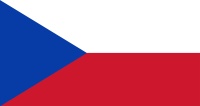Dja´s fauna
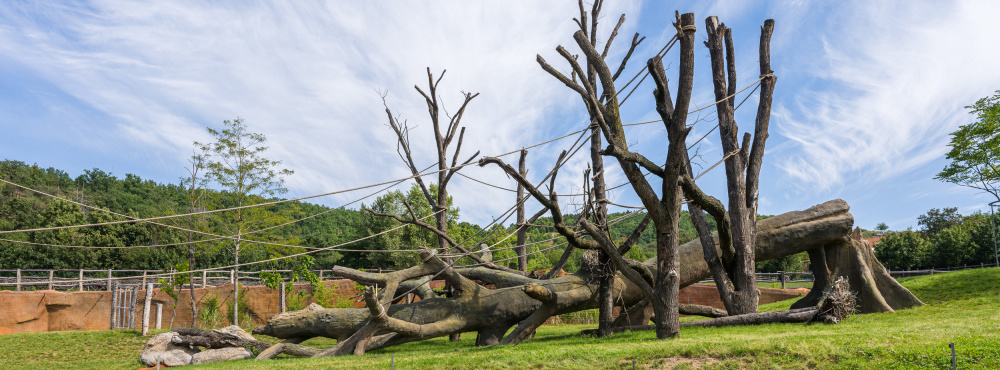
The forests of the Congo Basin are home to approximately 400 species of mammals, 1,000 bird species, 280 species of reptiles, more than 200 species of amphibians, 700 fish species—and countless invertebrates. Around a quarter of these can be found in the rainforests of Dja in southern Cameroon.
The Dja Biosphere Reserve plays a vital role in protecting threatened mammal species such as the western lowland gorilla, chimpanzee, mandrill, African forest elephant, and three species of pangolin. All of these animals—and many others—are in decline, mainly due to poaching and the loss of their natural habitat.
The key species in Cameroon’s Dja Reserve
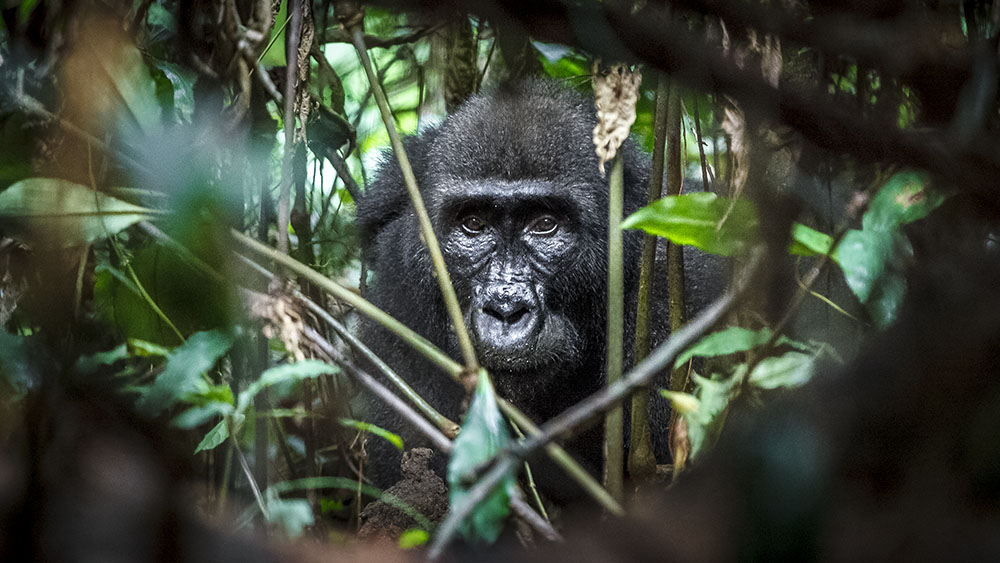
Photo: Lucie Vejmelková, Prague Zoo
Western lowland gorilla (Gorilla gorilla gorilla)
Although it is the most numerous gorilla subspecies with the widest range, its numbers in the wild are declining at an alarming rate. At this rate, within three generations (about 50 years) the gorilla population will decline by 80 %. Currently, about two-thirds of western lowland gorillas live in Congo, a quarter in Gabon and a tenth in Cameroon, with the vast majority (78 %) living outside protected areas. In the Dja Reserve, gorilla numbers are estimated at around 1,250 individuals.
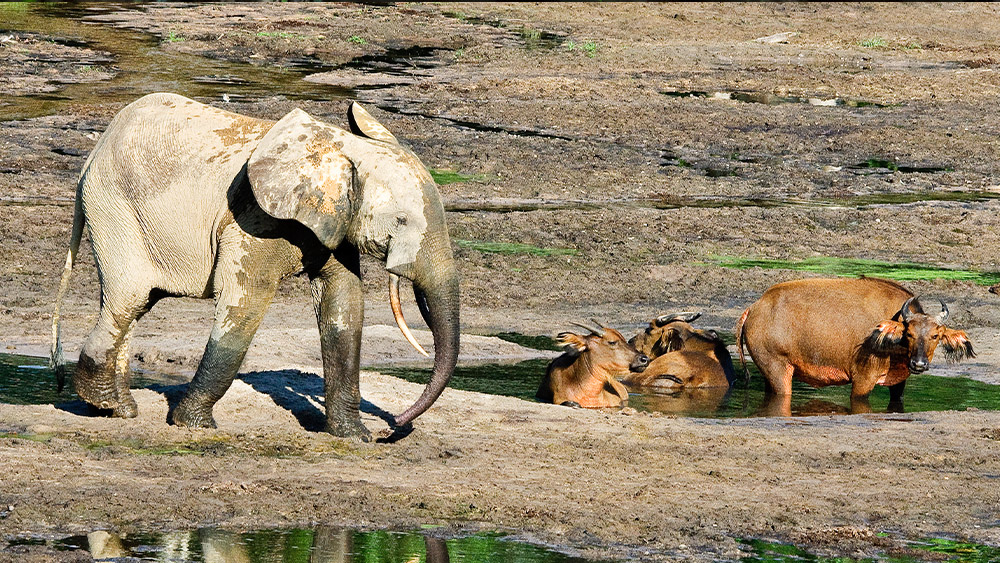
Rainforest clearings, known in central Africa as bais, serve as gathering places for animals seeking water, mud, minerals, or aquatic plants. They attract herds of African forest elephants and African forest buffalo (as seen in the photo), bongo antelopes, and even western lowland gorillas. This photo was taken in the Dzanga-Sangha Reserve in the Central African Republic, near the border with Cameroon. Photo: Miroslav Bobek, Prague Zoo
African forest elephant (Loxodonta cyclotis)
Large mammals such as elephants and great apes play a key role in forest ecosystems as seed dispersers. Studies have found seeds of some hundred different plant species in the dung of forest elephants. In this way, these animals contribute to forest regeneration and help maintain its biodiversity. Hunting them can disrupt relationships between species, which in turn may worsen the effects of climate change in the region.
Among farmers working the land near the rainforest, elephants are often seen as pests that damage crops. However, they are shot for a variety of reasons, including for their meat and ivory.
Globally, the population of African forest elephants has declined by more than half in a decade. In the Dja Biosphere Reserve, the drop has been even more dramatic. Around the year 2000, roughly 1,000 elephants still lived there. Today, their numbers are estimated at just 150 to 300 individuals.
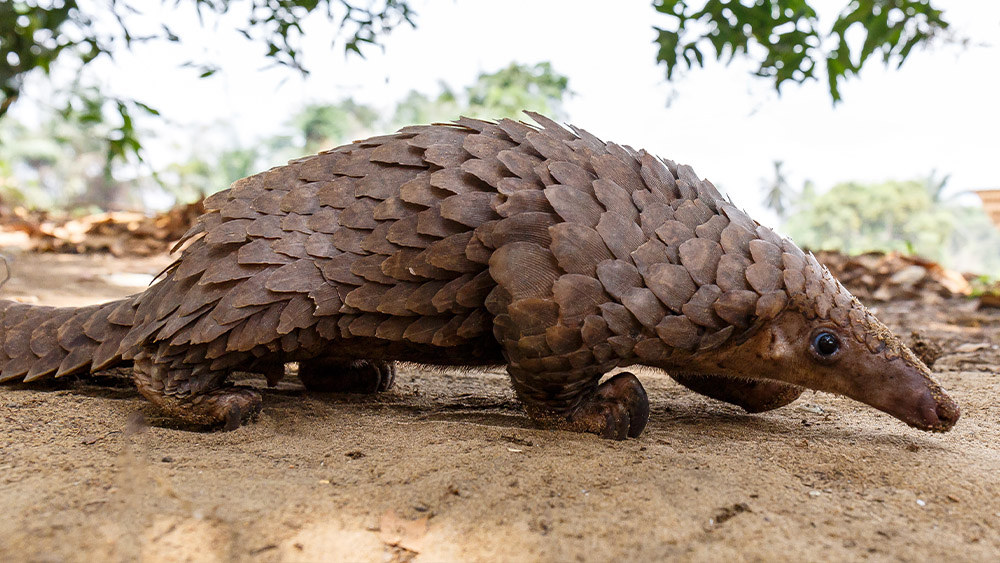
Tree pangolin for sale at a bushmeat street stall. Photo: Miroslav Bobek, Prague Zoo
Pangolins
Pangolins are probably the most smuggled mammals in the world today, mainly for their scales, which are used in traditional medicine in Asia. As the population of Asian pangolins can’t keep up with demand, attention has turned to Africa as well. On top of this, their meat is sought after as a luxury delicacy.
Three pangolin species live in the Cameroon’s Dja Reserve. Two of them are arboreal: the tree pangolin (Phataginus tricuspis), and the long-tailed pangolin (Phataginus tetradactyla). The third one is terrestrial: the giant pangolin (Smutsia gigantea).
Other animals from Dja
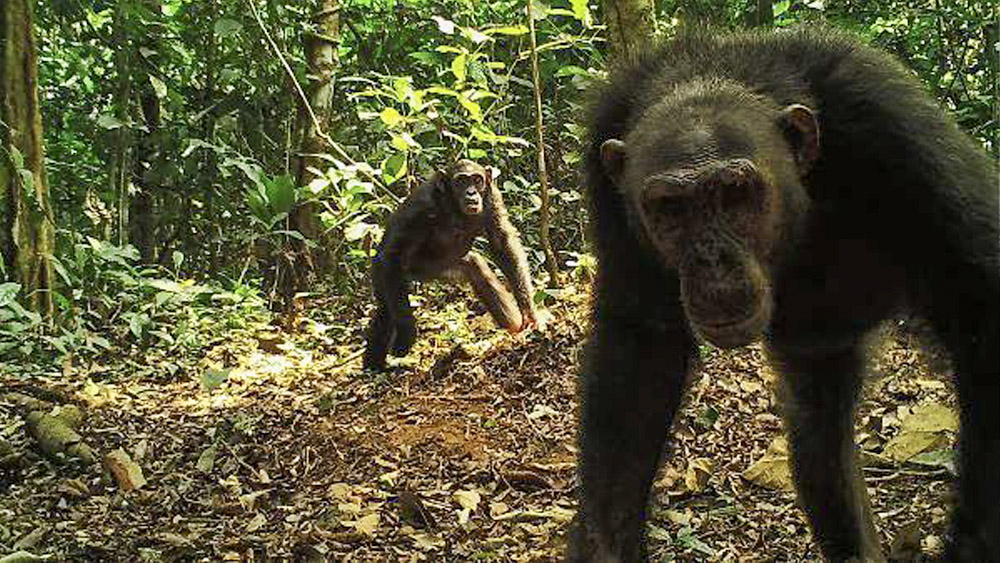
Chimpanzees from Dja captured by a camera trap. Photo: Ministry of Forestry and Wildlife, Cameroon / Zoological Society of London
Chimpanzee (Pan troglodytes troglodytes)
In central Africa, chimpanzees and western lowland gorillas share much of the same range. Even though the chimpanzee population is smaller, it is more stable than that of the gorillas. This is likely because it is generally more difficult for a poacher to shoot a chimpanzee than a gorilla. Chimpanzees have the advantage of being smaller, more agile and nomadic. Their groups roam the forest, unlike gorillas, whose troops are more sedentary. All of this makes chimpanzees much more elusive prey. Even so, they are still listed as Endangered on the IUCN Red List. The number of chimpanzees in the Dja Reserve is estimated at 2,300 individuals.
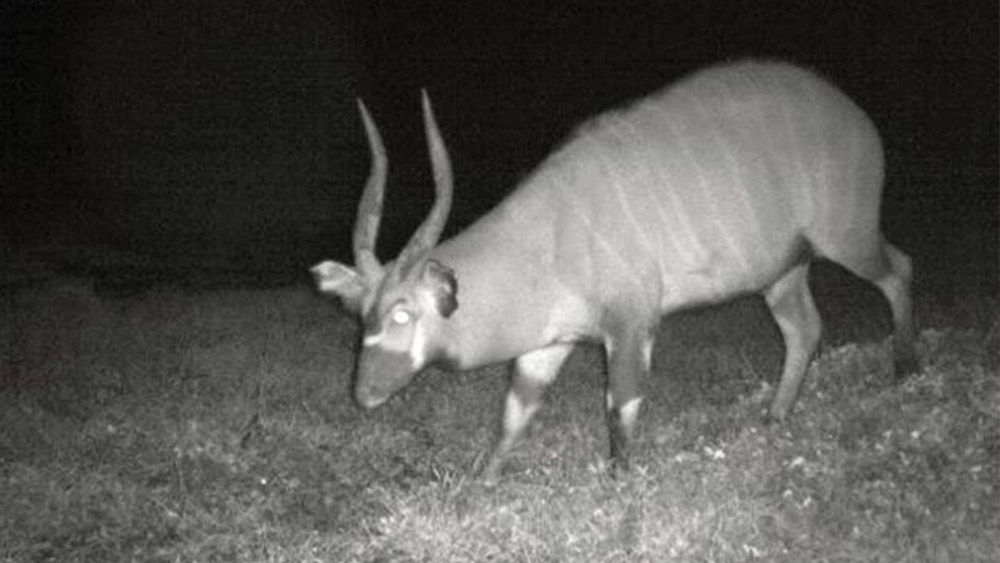
Western bongo captured by a camera trap that we provided to rangers of the Dja Biosphere Reserve.
Western bongo (Tragelaphus eurycerus eurycerus)
A secretive antelope, in which males tend to live alone, while females may form small groups. Larger numbers gather in forest clearings. The western bongo is widely distributed across the forests of the Congo Basin and West Africa. Unlike its critically endangered relative, the eastern bongo, which we keep at Prague Zoo, this subspecies is relatively common.
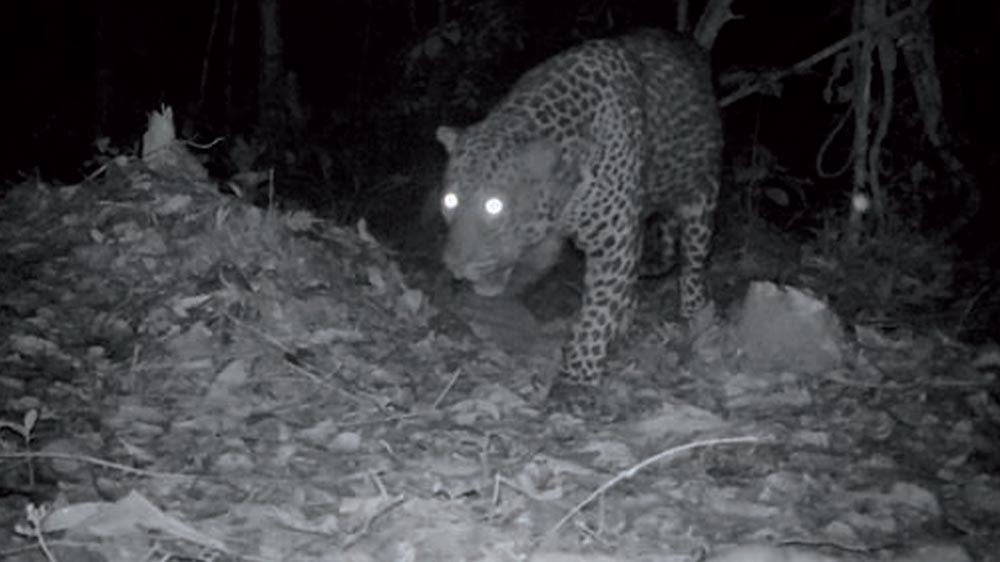
Leopard captured by a camera trap in the Dja Biosphere Reserve. Photo: Ministry of Forestry and Wildlife, Cameroon / Zoological Society of London
Leopard (Panthera pardus)
The leopard is an apex predator of the African rainforest. However, it is quite rare in the forests of Dja: since the mid-1990s, its presence has been confirmed only twice. As the largest carnivore in the area, it is feared, and encounters with humans rarely end well for the leopard. In traditional medicine, its bones are sometimes used as an aphrodisiac.
Birds
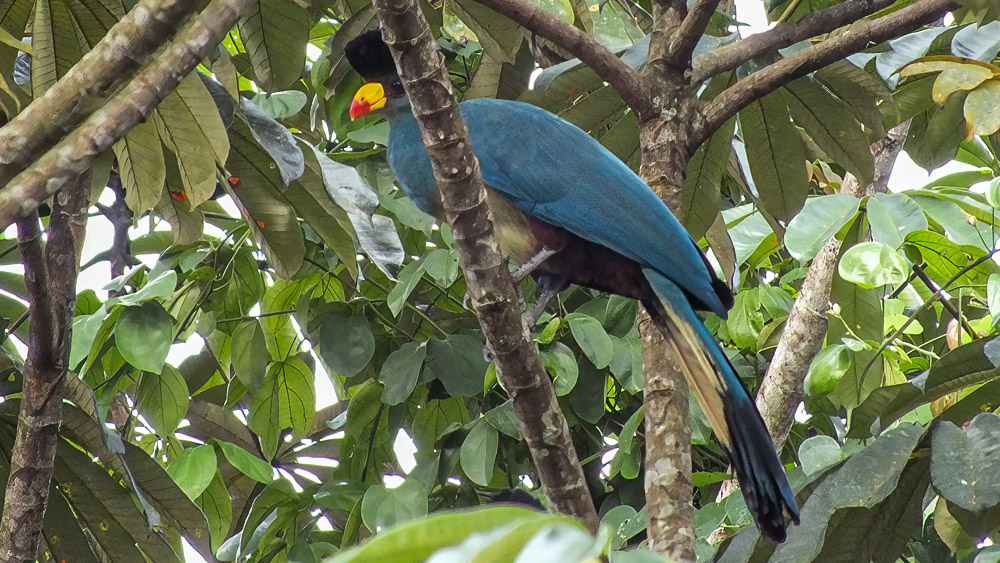
Great blue turaco. Photo: Daniel Frynta
Around 360 bird species have been recorded in the Dja region. The great blue turaco (Corythaeola cristata) is one of the species that can be encountered quite commonly, often gathering in small groups. Turacos form a distinct order with unclear evolutionary relationships. They feed mainly on plant matter, including fruits, and play an important role in seed dispersal. The same is true for hornbills, several species of which also live in Dja—although hornbills will readily take small animals as well.
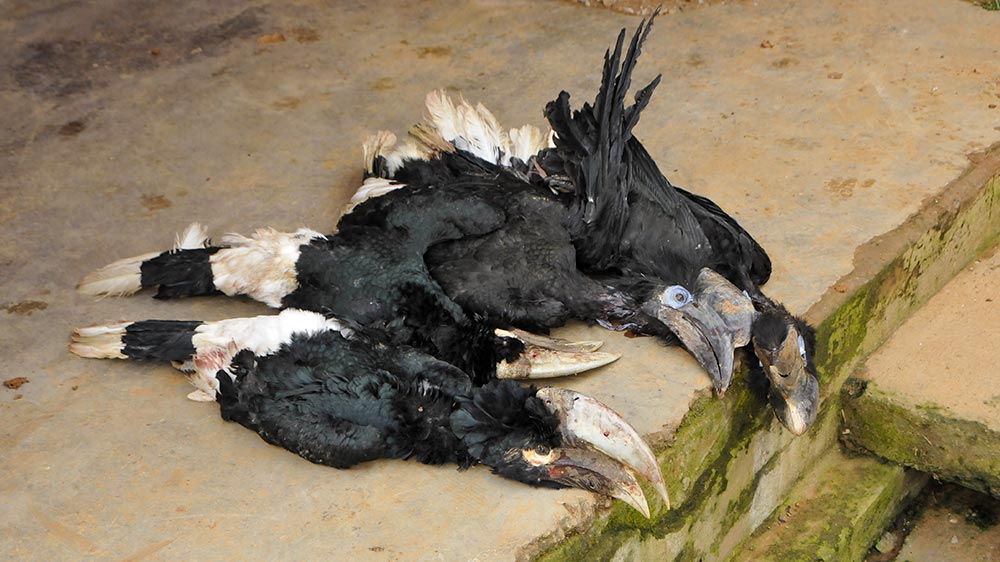
Black-casqued hornbills (Ceratogymna atrata) killed by poachers near the Dja Reserve. Photo: Miroslav Bobek, Prague Zoo
The popular pet bird known as the grey parrot, or African grey (Psittacus erithacus), originates from the forests of central Africa. However, due to excessive poaching and the pet trade, it has become an endangered species. More than half of the parrots caught die before they even reach the market. In 2016, all international trade in this species was therefore banned under the CITES convention.
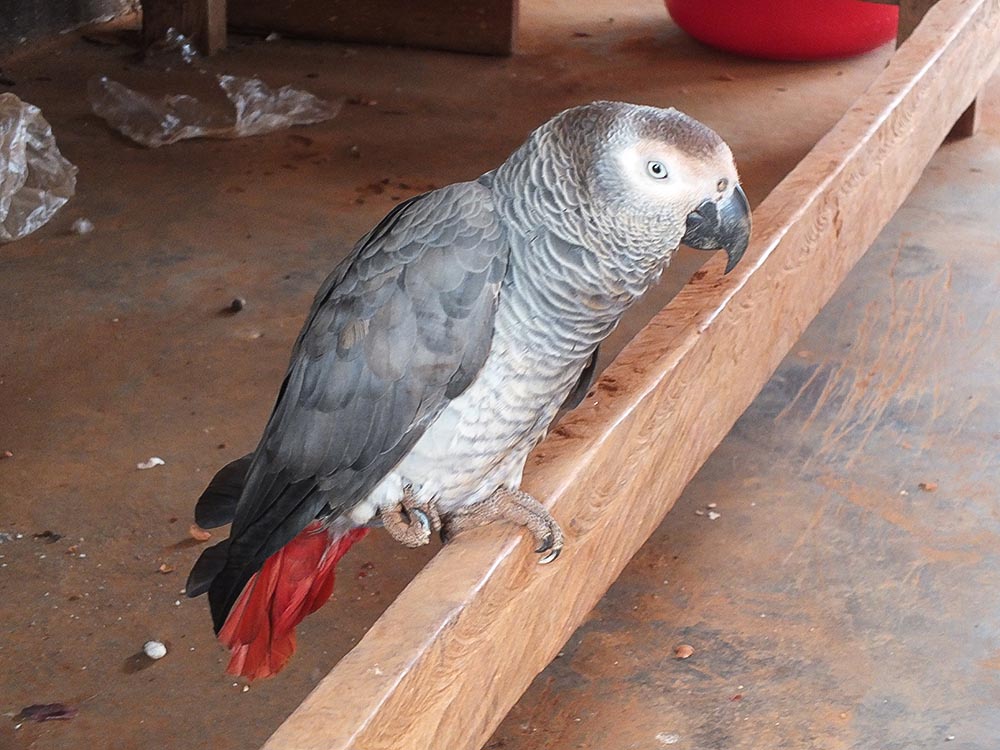
Grey parrots are occasionally kept by people living near the reserve as well. Photo: Daniel Frynta
A remarkable species is the grey-necked rockfowl (Picathartes oreas), which lives exclusively in the forests of central Africa. It belongs to its own family, characterised by colourful patches of bare skin on the head. Beneath rocky overhangs it constructs cup-shaped nests out of mud. It feeds on insects and small vertebrates. It even deliberately follows columns of aggressive Dorylus ants, picking off the insects they have captured. Around 50 pairs of this songbird nest in Dja.
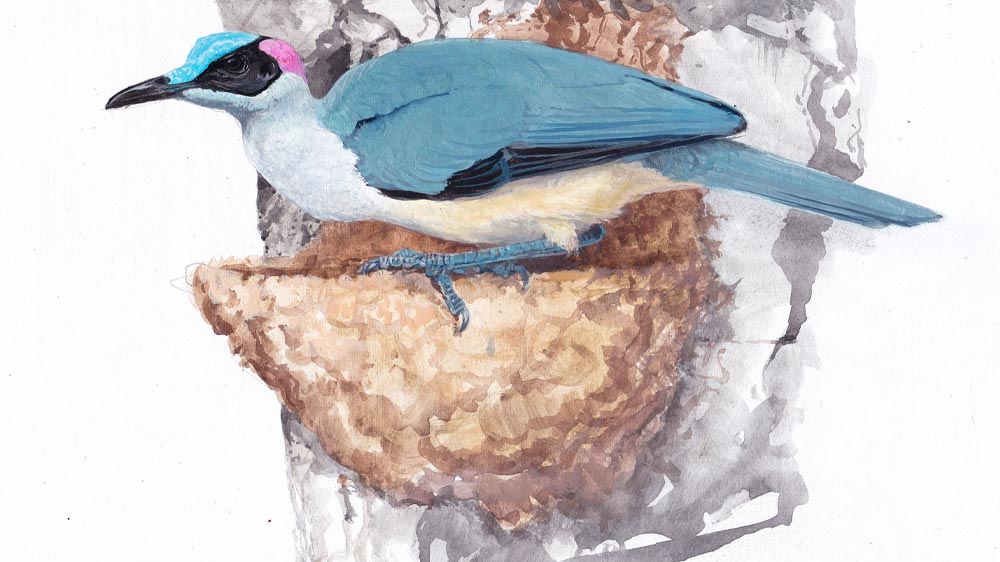
Grey-necked rockfowl. Illustration: Pavel Procházka
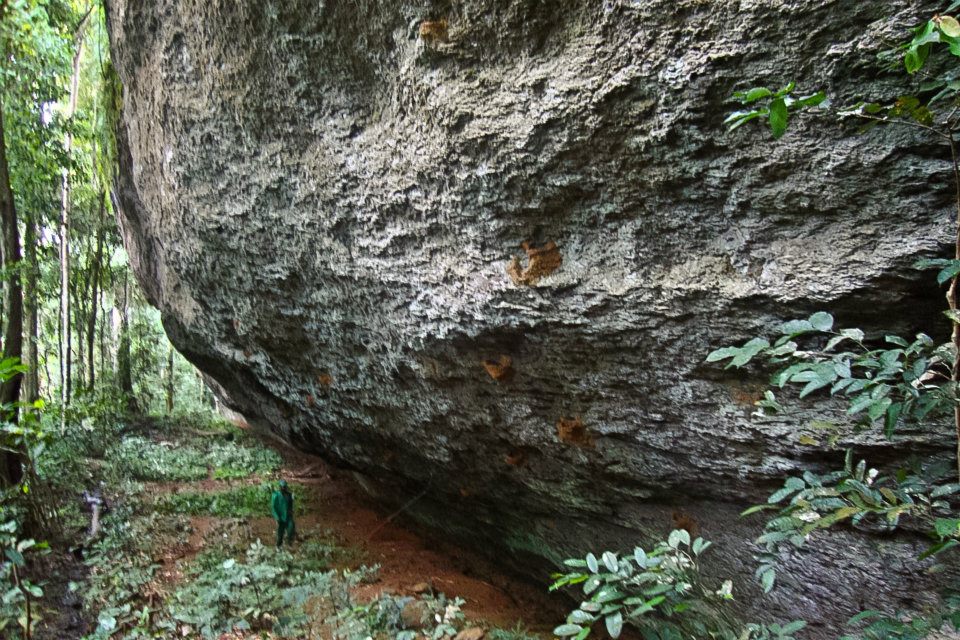
Grey-necked rockfowl nests in Dja. Photo: Madjaye Stéphane Maril
Reptiles, amphibians, and fish
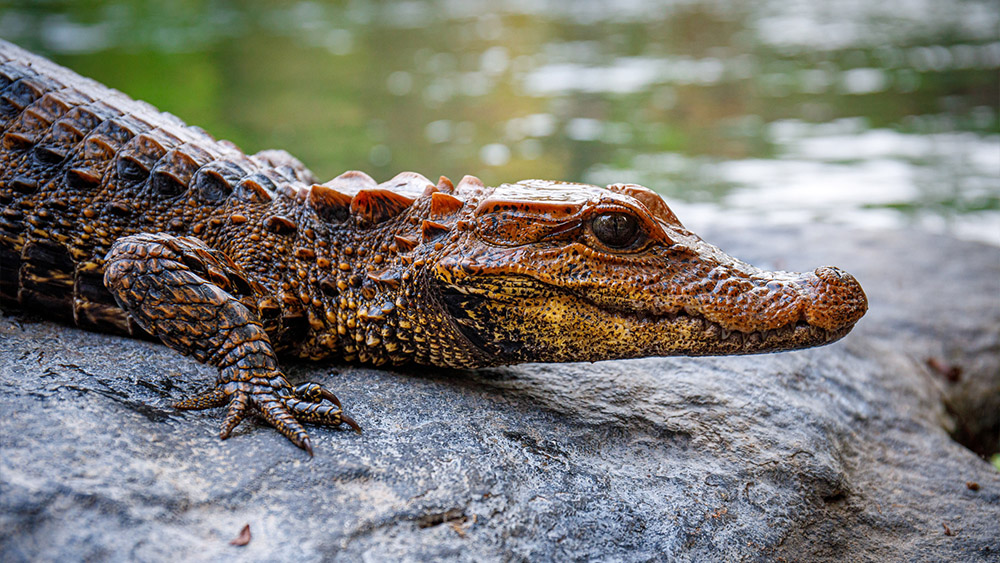
A young Osborn’s dwarf crocodile, confiscated from poachers by reserve rangers, was released back into the Dja River. Photo: Miroslav Bobek, Prague Zoo
The Osborn’s dwarf crocodile (Osteolaemus osborni) was until recently considered a subspecies of the African dwarf crocodile. It is now thought that these are in fact two distinct species. This is a relatively small crocodile, reaching a length of “only” about 1.5 metres. Thanks to its small size and similar body structure, it can resemble South American caimans. In addition to fish and small vertebrates, it also feeds on large invertebrates such as molluscs and crustaceans.
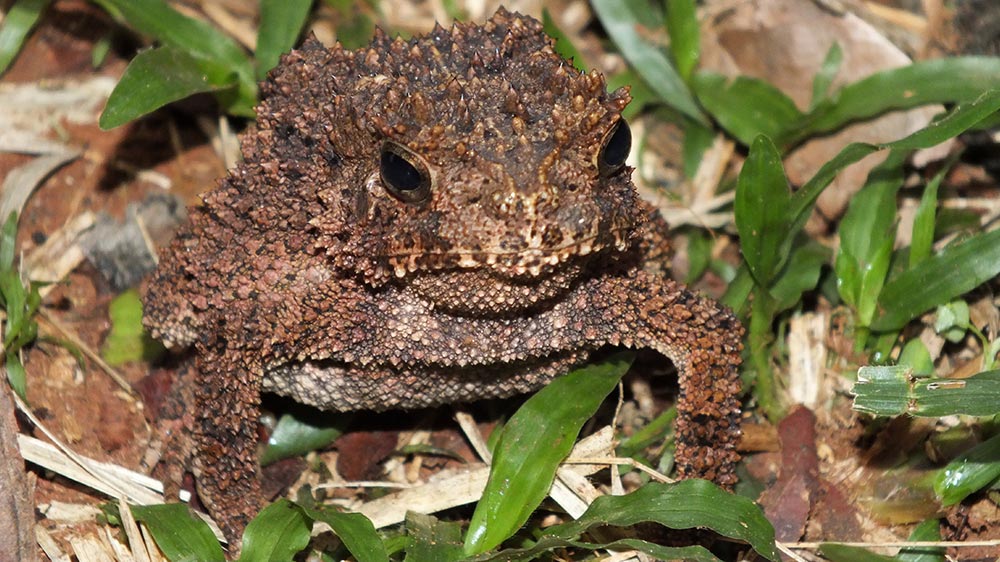
Amphibians are among those animals that often go unnoticed. The Fernando Po toad (Sclerophrys tuberosa) is characterised by its many pointed skin projections, which provide both camouflage and physical protection. Photo: Daniel Frynta
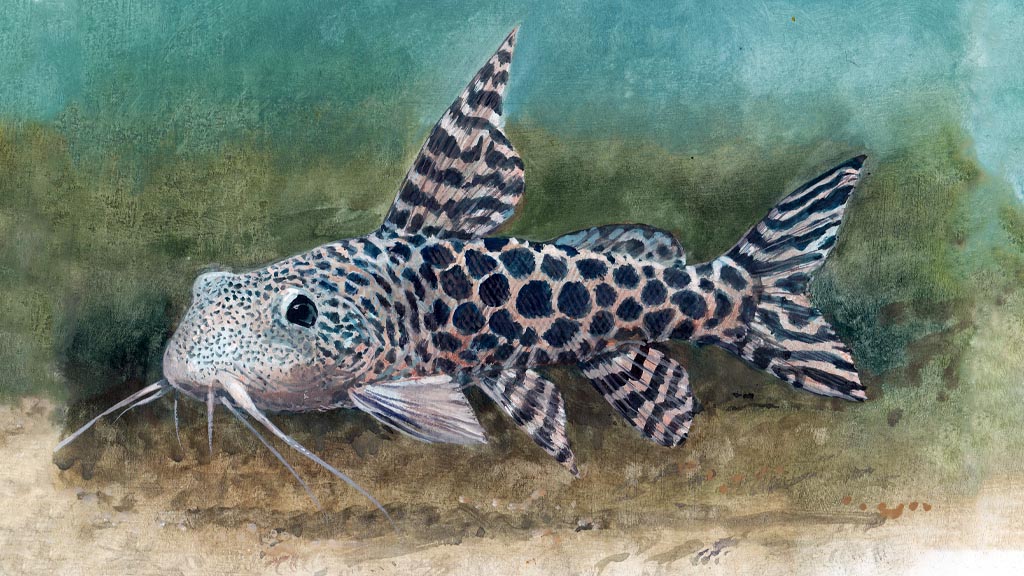
The Dja River also has its own endemic fish species, the leopard squeaker (Synodontis pardalis), which is also kept as an aquarium fish. Illustration: Pavel Procházka
Threats to wildlife in Cameroon’s Dja Reserve
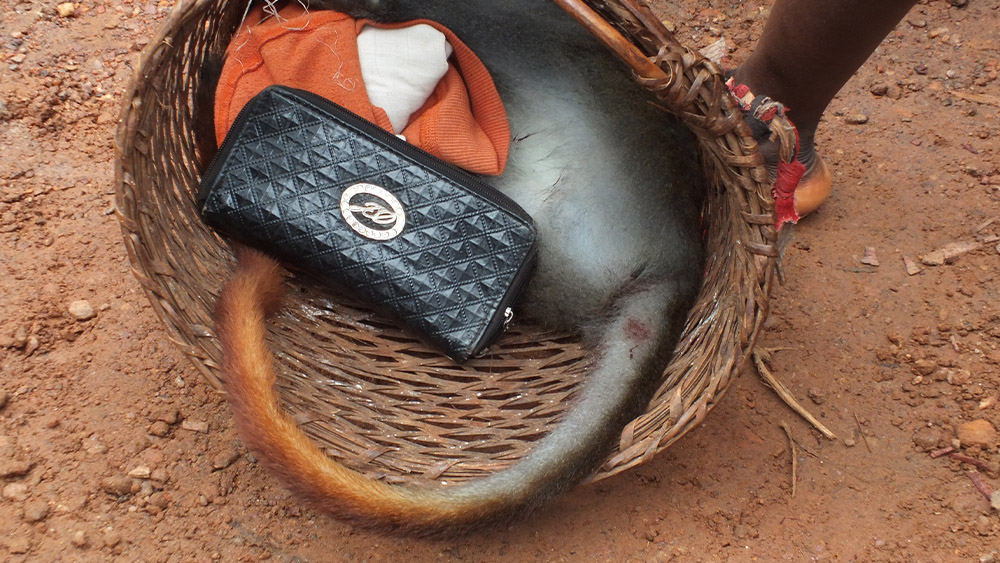
Photo: Daniel Frynta
Poaching
Poaching is a significant threat to local wildlife—not so much due to subsistence consumption of bushmeat on site, but because of market demand, whether driven by urban consumers or, in the case of pangolins, by the illegal trade in their scales, which are exported on a large scale to Asia for use in traditional medicine.
Hunting common species is permitted only for personal consumption and cannot involve any further sale; the killing of endangered species is absolutely forbidden. For example, killing a gorilla can incur a fine of three to five million Central African francs (roughly 4,500 to 7,600 €) and a prison sentence of five to seven years.
Poachers operate both individually and in gangs. Snares and firearms are the most common methods. At the same time, there are too few rangers to effectively patrol all access routes. In 2022, there were only around 60 rangers—one per 8,800 hectares.
Forest burning
Burning forest is mostly carried out to clear land for cultivation. Under Cameroonian law, whoever burns a piece of forest can claim the land as their own. This not only reduces continuous forest cover and protected area—as burnt areas are subsequently removed from the reserve—but also further restricts the Baka people, who have traditionally been nomadic and therefore cannot officially hold title to any land.
Mékin Dam
The Mékin Dam is located on the Dja River’s western bend and was completed in 2018. It was built by the China National Electric Engineering company and has a capacity of 940 million cubic metres of water and 15 megawatts of power, supplying electricity to eight communes. However, its construction failed to take into account sufficient environmental and social impacts. The flooding of a vast area deprived some local people of agricultural land, potentially leading to socio-economic hardships and an increase in poaching. Forests around the flooded area may also be downgraded in status, allowing logging companies further access. The dam has also negatively affected water quality.
ZOOPRAHA.CZ
Contacts
- The Prague zoological garden
U Trojskeho zamku 120/3
171 00 Praha 7
Phone.: (+420) 296 112 230 (public relations department)
e-mail: zoopraha@zoopraha.cz
Others



